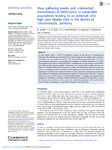2020-10-13Zeitschriftenartikel
Mass gathering events and undetected transmission of SARS-CoV-2 in vulnerable populations leading to an outbreak with high case fatality ratio in the district of Tirschenreuth, Germany
Brandl, Michael
Selb, Regina
Seidl-Pillmeier, Susanne
Marosevic, Durdica
Buchholz, Udo
Rehmet, Sybille
In early March 2020, a COVID-19-outbreak occurred in the district of Tirschenreuth, Germany. The outbreak was characterised by a rapid increase in case numbers and a comparatively high crude case fatality ratio (CFR; 11%). Until the beginning of May 2020, 1122 cases were reported in the district. To investigate the outbreak, we analysed surveillance and other data available at the district health department, including data on cases living in care facilities and public health measures applied. Furthermore, we compared the number of tests performed in Tirschenreuth and in Germany as a whole. We interviewed the first 110 cases in order to investigate potential exposures at the beginning of the outbreak. We found that returning ski-travellers from Austria and Italy and early undetected community transmission likely initiated the outbreak which was then accelerated by Bavarian beer festivities. Testing of mainly acute cases in the district of Tirschenreuth resulted in a higher rate of positive tests compared to the whole of Germany. Despite adjustment for age, the CFR continued to exceed the German mean which was due to spread to vulnerable populations. Strict public health measures likely contributed to control the outbreak by mid-April 2020.
Dateien zu dieser Publikation

